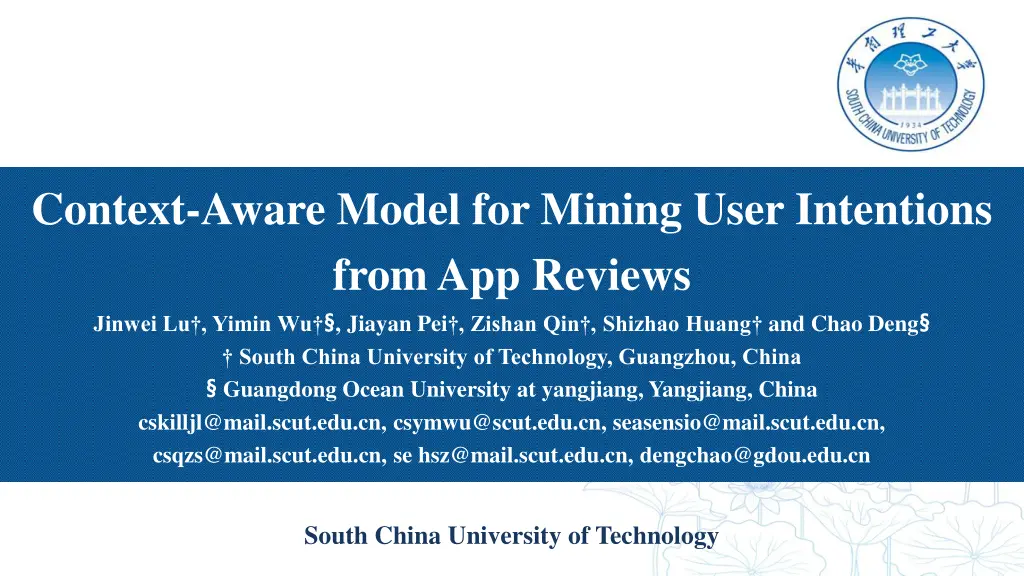
Mining User Intentions from App Reviews with Context-Aware Model
Analyzing and filtering user intentions from app reviews is crucial for understanding valuable information. This study introduces a Context-Aware Model to extract user intentions like Information Giving, Information Seeking, Feature Request, and Problem Discovery from raw text sentences in app reviews. By utilizing techniques like Word Embedding and Local Feature Extraction, this model enhances the efficiency of intention mining for app maintenance and evolution.
Download Presentation

Please find below an Image/Link to download the presentation.
The content on the website is provided AS IS for your information and personal use only. It may not be sold, licensed, or shared on other websites without obtaining consent from the author. If you encounter any issues during the download, it is possible that the publisher has removed the file from their server.
You are allowed to download the files provided on this website for personal or commercial use, subject to the condition that they are used lawfully. All files are the property of their respective owners.
The content on the website is provided AS IS for your information and personal use only. It may not be sold, licensed, or shared on other websites without obtaining consent from the author.
E N D
Presentation Transcript
Context-Aware Model for Mining User Intentions from App Reviews Jinwei Lu , Yimin Wu , Jiayan Pei , Zishan Qin , Shizhao Huang and Chao Deng South China University of Technology, Guangzhou, China Guangdong Ocean University at yangjiang, Yangjiang, China cskilljl@mail.scut.edu.cn, csymwu@scut.edu.cn, seasensio@mail.scut.edu.cn, csqzs@mail.scut.edu.cn, se hsz@mail.scut.edu.cn, dengchao@gdou.edu.cn South China University of Technology
Background Analyzing and filtering user intentions from app reviews. Filter useless reviews and classify different intentions. Intentions of reviews can help better understand valuable information for app maintenance and evolution. The artificial recognition method is inefficient and time-consuming. Automated approaches are required. 2025/5/28 2 Context-Aware Model for Mining User Intentions from App Reviews
Previous Methods Machine learning method Fig. 1. Machine learning methods framework[5] Requiring the manual design of recurrent linguistic patterns. Do not fully use the semantic information in review. Context-Aware Model for Mining User Intentions from App Reviews
Previous Methods Deep learning method Fig. 2. Deep learning methods framework[7] Can not sufficiently consider the contextual information of the whole review. Context-Aware Model for Mining User Intentions from App Reviews
Our work - MIAR Framework Mining Intention from App Reviews (MIAR) Input: an app review (raw text sentences of a user review). Output: user intention categories of app review (Information Giving, Information Seeking, Feature Request, Problem Discovery). Context-Aware Model for Mining User Intentions from App Reviews
Our work - MIAR Framework Word Embedding Layer Transform each word into a vector representing through pre-trained word embeddings. Add POS tag information into word vectors to augment its ability of feature representation. Context-Aware Model for Mining User Intentions from App Reviews
Our work - MIAR Framework Local Feature Extractor Adopt TextCNN to extract the local feature in the text sequence, which can catch semantic features of different n-grams in the input, representing the local feature vector. Context-Aware Model for Mining User Intentions from App Reviews
Our work - MIAR Framework Contextual Feature Extractor Adopt BiLSTM to fuse contextual information into each word s original representation. Add a convolutional layer to abstract the contextual feature, which can condense the rich information extracted by BiLSTM. Context-Aware Model for Mining User Intentions from App Reviews
Our work - MIAR Framework Fusion Layer Integrate the local representation and the contextual representation of word to generate the intention representation. Context-Aware Model for Mining User Intentions from App Reviews
Our work - MIAR Framework Prediction Layer Use max-pooling to convert vectors into fixed-size vectors. Apply softmax function to obtain the probability of each class. Context-Aware Model for Mining User Intentions from App Reviews
Experiment Setup Dataset Built by Panichella et al. [5], contains 1421 review sentences. App reviews have four user intention classes: Information Giving (IG) Information Seeking (IS) Feature Request (FR) Problem Discovery (PD) Use 3-folds cross-validation to evaluate the performance. Context-Aware Model for Mining User Intentions from App Reviews
Experiment Results MIAR outperforms the previous methods in all four classes. Context-Aware Model for Mining User Intentions from App Reviews
Ablation Study The Contextual Feature Extractor plays an essential role in the performance improvement of MIAR. Context-Aware Model for Mining User Intentions from App Reviews
Experiment Results The generalization ability of MIAR Dataset: Two intention mining datasets proposed by Di Sorbo et al. [9] and Huang et al. [7], respectively. Context-Aware Model for Mining User Intentions from App Reviews
Contributions Propose MIAR for app review intention mining task, which can capture the global feature for better gaining the context sematic information and understanding user intentions. MIAR not only outperforms previous methods in app review domain, but also have a good performance in other software engineering domains. Context-Aware Model for Mining User Intentions from App Reviews
Thanks! Context-Aware Model for Mining User Intentions from App Reviews
